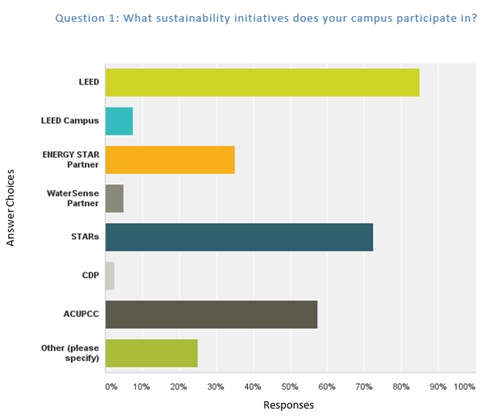This past year, Leonardo Academy conducted a survey to gain a deeper understanding of the current use of the LEED rating system on college and university campuses within the landscape of the many sustainability programs, tools, and metrics available today. The findings indicated a major difference between LEED for new construction versus for existing buildings, and have implications as to how buildings can remain green for much longer than they do.
Leonardo Academy conducted the survey over a 12-week period from May through August 2016. Forty colleges and universities throughout the United States contributed responses representing 24 U.S. states and each primary geographic U.S. region (Northeast, Southeast, South, Midwest, West, Southwest, and Northwest).
The responses gathered offer insight into the level of LEED participation compared to other available programs, as well as driving factors for pursuing LEED and its specific applications (for New Construction, Existing Buildings, and ongoing recertification), level of importance to key stakeholders, benefits and challenges to pursuing campus sustainability through LEED, and more. Many of the survey’s key findings apply to sustainable facility management beyond the campus setting.
Survey Analysis
The results of survey Question 1 provide a snapshot of the use of LEED by college and universities compared to other available sustainability programs and metrics, including LEED Campus, the EPA’s ENERGY STAR Partner® program, the EPA’s WaterSense® Partner program, the Sustainability Tracking, Assessment, and Rating System™ (STARS), the Carbon Disclosure Project (CDP), the American College & University Presidents’ Climate Commitment (ACUPCC) supported by Second Nature, and others. As Figure 1 reveals, LEED is the sustainability initiative with the highest campus participation rate, followed closely by the STARS program.
The survey also asked respondents about their previous practices in pursuing LEED certification for new and existing facilities. Figure 2 shows that while 45% of respondents claim to certify 76% to 100% of New Construction projects, 97% of respondents reported that less than 25% of their existing buildings are LEED EB O+M certified.
Question five revealed that nearly 60% of those who earn LEED certification for New Construction projects do not maintain ongoing Existing Building recertification for those buildings.
Despite these numbers, survey question eight revealed that, among respondents, the primary benefits of earning ongoing LEED for Existing Buildings, Operations and Maintenance (LEED EB O+M) recertification for buildings on campus are seen as energy and water savings, catering to the interest of current students, and catering to the interest of current staff.
The survey also asked respondents to rank their stakeholders according to level of sustainability importance; that is, how important the respondent perceives sustainability to be to that stakeholder group. Results demonstrate that campus sustainability is believed to be most important to current students, followed by potential students, current staff, potential staff, donors, and alumni. As such, engaging all the campus audiences including current and prospective students, current and potential staff, alumni and donors in supporting campus sustainability offers an opportunity for driving increased implementation of campus sustainability and LEED for campus buildings.
Key Takeaways
Though these findings are based on facility and sustainability managers in institutions of higher education, a few key takeaways remain universally relevant:
The major driver as to whether going green is important is the building user
First, while the specific stakeholder groups included in the survey apply to just institutions of higher education, it remains true for all facilities that the number one stakeholder is the user. The population that inhabits the building can be a major driver in deciding to pursue green action and improving the quality of the interior space.
LEED-EB is very important for maintaining the improved performance of a newly constructed LEED building
It appears that LEED EB is an under-utilized opportunity to increase the sustainability of existing building stock. Given these survey results, it appears that there is a chance for campuses and facility managers in general to put the LEED EB O+M rating system to work in maintaining the performance of LEED for New Construction (LEED NC) certified buildings, and improving the performance of existing buildings not previously certified under the LEED rating system. Although respondents identify the numerous benefits of pursuing LEED EB, very few choose to do so.
Ongoing LEED EB O+M certification for LEED NC certified buildings ensures that the high level of sustainability performance set during the construction process is maintained or improved. The LEED EB rating system can also be used to upgrade and maintain the ongoing performance of existing buildings on campus. With the opportunity to capitalize on existing building sustainability comes the opportunity to incur all of the benefits of sustainable.


